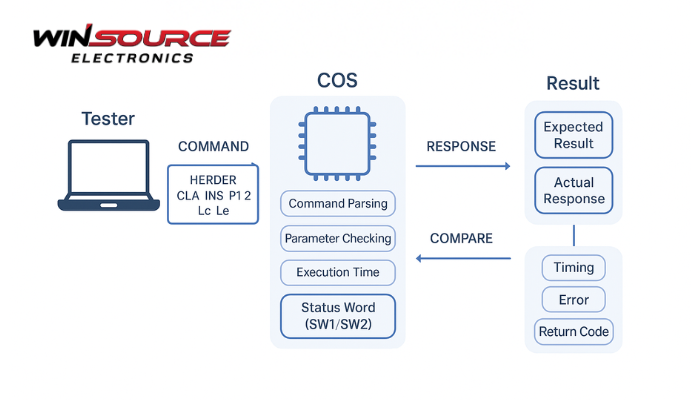
* Question
What is the principle of parameter testing in COS functional testing?
* Answer
In Chip Operating System (COS) functional testing, parameter testing is a key process used to verify whether the internal functions and communication mechanisms of a smart card or embedded security chip perform within defined operational limits. The goal is to ensure that the command-response behavior, data integrity, and timing characteristics of the COS meet the design specifications and interoperability requirements.
1. Overview of COS and Parameter Testing
The COS (Chip Operating System) is the embedded software that manages file structures, communication protocols, security algorithms, and I/O interactions within a smart card or secure IC.
Parameter testing focuses on validating how the COS handles commands, responses, and timing parameters under various conditions — ensuring functional correctness and reliability.
2. Command–Response Mechanism Verification
At the core of COS operation is the APDU (Application Protocol Data Unit) communication model, which follows the ISO/IEC 7816 standard.
Parameter testing verifies:
- Whether the COS correctly parses incoming command parameters(e.g., CLA, INS, P1, P2, Lc, Le).
- Whether response data and status words (SW1/SW2)are returned accurately and consistently.
For example, when a “SELECT FILE” command is sent, the COS should respond with the correct file descriptor and a status code (e.g., 9000 for success).
3. Timing and Performance Evaluation
Parameter testing also measures execution time for different COS instructions to ensure they fall within acceptable limits.
- Response timetests verify whether the COS reacts within the required timing window after receiving an APDU command.
- Delays or abnormal response intervals may indicate processing inefficiencies or potential firmware defects.
These timing evaluations are especially important for contactless cards(e.g., ISO/IEC 14443), where communication timing directly affects transaction reliability.
4. Boundary and Stress Condition Validation
The COS is tested with boundary conditions — such as maximum-length data fields or edge-case parameter values — to evaluate its robustness and error handling.
Typical checks include:
- Handling of invalid command codes or parameters.
- Behavior under buffer overflow, checksum mismatch, or transmission errors.
The system’s ability to return proper error codes (e.g., 6A86for incorrect parameters) is an important validation of software integrity.
5. Security and Consistency Checks
Parameter testing also ensures that security-sensitive commands (such as authentication, key management, or PIN verification) behave correctly under valid and invalid input conditions.
This includes verifying whether:
- The COS rejects unauthorized operations.
- Session parameters reset properly after errors.
- Secure messaging (SM) parameters follow cryptographic protocol standards.
Summary
Test Dimension | Purpose |
Command–response verification | Validate APDU command parsing and response correctness |
Timing evaluation | Confirm response latency within defined limits |
Boundary testing | Check robustness under extreme parameter values |
Error handling | Ensure consistent and standard-compliant status responses |
Security validation | Verify secure command behavior and state transitions |
In summary, the principle of parameter testing in COS functional testing is to quantitatively assess the correctness, timing, and robustness of command processing within the chip’s operating system. By verifying every parameter’s impact on functional and security behavior, engineers ensure that the COS performs reliably under real-world application scenarios such as payment, identification, and secure authentication.

COMMENTS